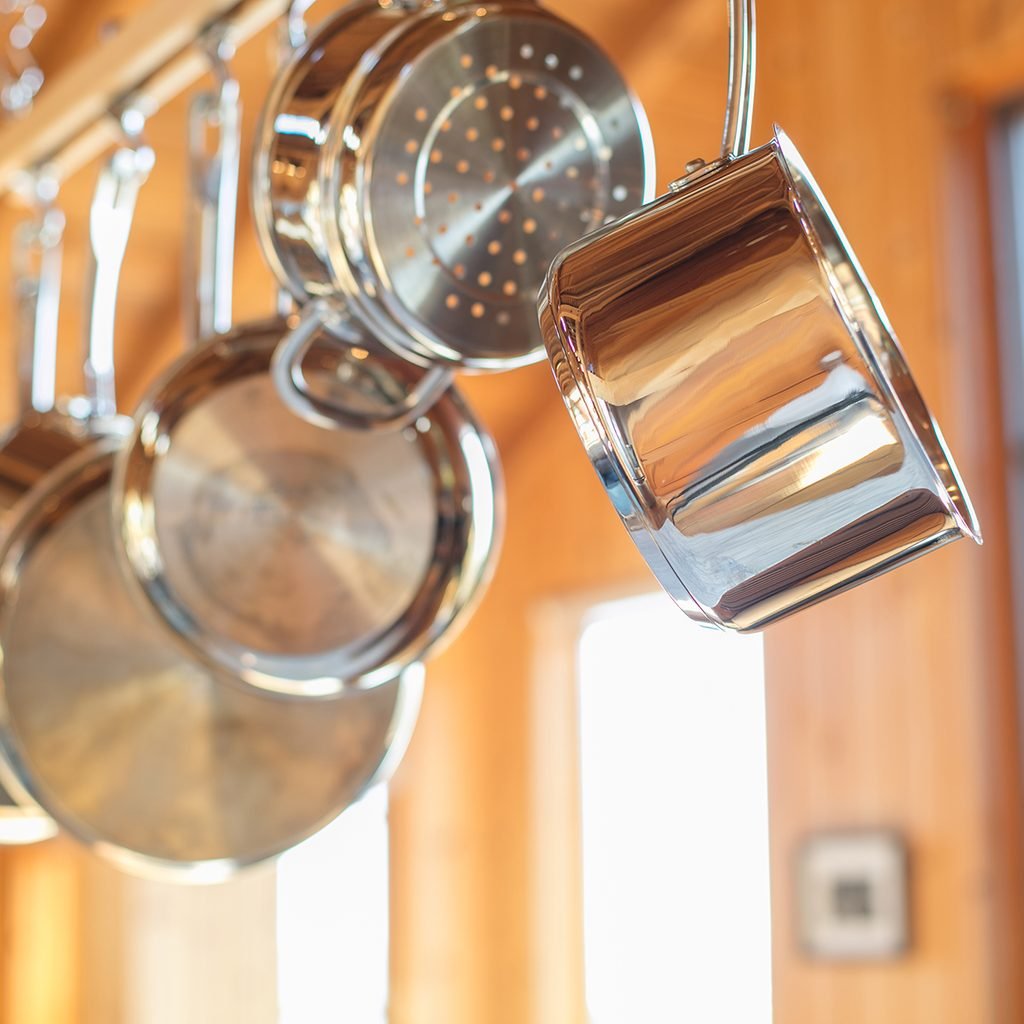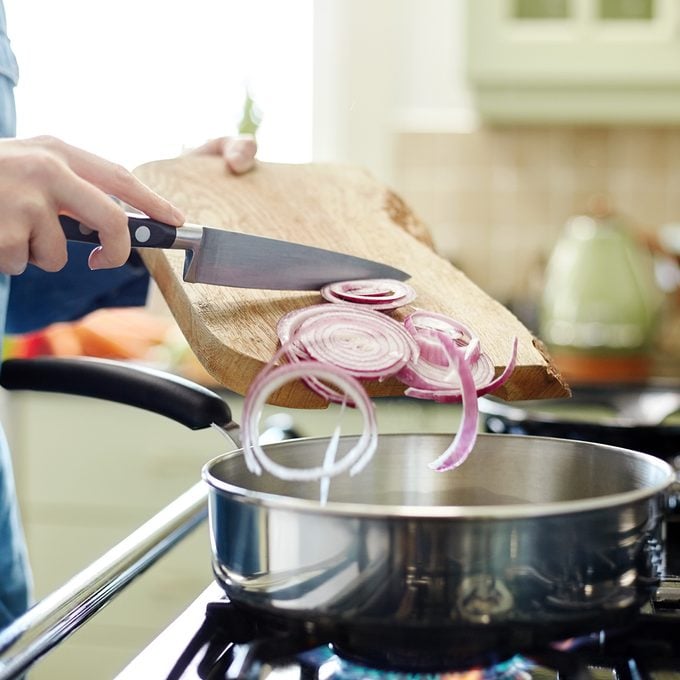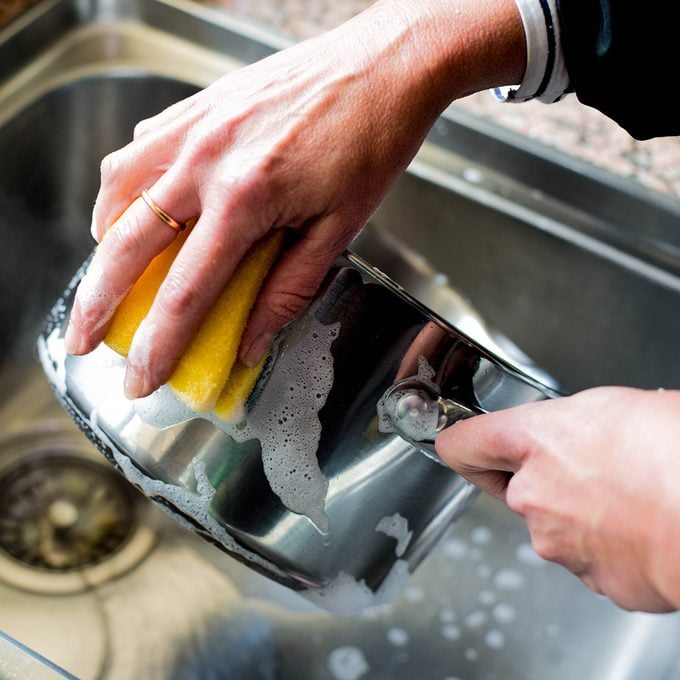How to Cook with Stainless Steel
Updated: Dec. 08, 2023

A complete guide for how to cook with (and care for!) stainless steel.
Our editors and experts handpick every product we feature. We may earn a commission from your purchases.
Stainless steel pots and pans are great for many reasons. I prefer using them over nonstick cookware for things like searing meat, as it leaves behind pieces of fond that are the perfect start to many dishes—like these sage pork chops with cider pan gravy. We’ll help you make the most out of your stainless steel cookware set, including how to avoid a few mistakes that can shorten the lifespan of your pans.
Benefits of Stainless Steel
There are several different types of cookware, but stainless steel pans can be a kitchen workhorse. They’re lighter than cast-iron, more durable than non-stick pans and many brands are magnetic for induction cooktops. The material doesn’t react to any foods, so you can use a stainless steel pan for just about any cooking task.
One of the most common questions people ask is, “Are stainless steel pans better than nonstick?” Yes, and no. Most inexpensive non-stick pans are made with aluminum, which heats up quickly but isn’t suitable for high-temperature cooking. You also can’t get a hard sear in a nonstick pan, as the coating prevents the surface of the food from browning. That’s why I generally prefer using stainless steel pans for most tasks, but it’s totally worth having a nonstick frying pan for preparing notoriously sticky foods, like eggs or pancakes.
Tips for Cooking with Stainless Steel

How to Keep Food From Sticking to Stainless Steel
The most annoying thing about stainless steel pans is that food loves to stick to its surface as it cooks. Luckily, this can be prevented by doing two simple things. First, always make sure to preheat the pan before cooking. After two to three minutes, add thin layer of cooking oil to the pan. When it starts to shimmer, the pan is ready to use. Another way to test if the pan is hot enough is to add a drop of water to the pan. The water should make a “TSS” sound, split into multiple droplets and evaporate.
Seasoning Stainless Steel
Although seasoning isn’t required with stainless steel pans, it is possible to season your favorite skillet to create a non-stick layer. Heat the pan over medium-high heat for about two minutes. Add a thin layer of vegetable oil to the pan (about 1/8 inch). Continue to heat the pan until the oil just begins to smoke, about 5 minutes. Remove the pan from the heat and let it cool completely before discarding the oil. Wipe the pan with a paper towel, and voila: You now have a non-stick surface.
Don’t Neglect the Oven
Although Dutch ovens get the most exposure as being stovetop- and oven-friendly pans, you can also use your stainless steel pans in the oven. Check with the manufacturer to make sure your pan is oven-safe, but most high-quality stainless steel is rated for temperatures up to 500°. That makes them great for creating one-dish pasta recipes, but you can also use them to sear thick steaks and pork chops on the stovetop and finish cooking them in the oven.
Stainless Steel Care Mistakes to Avoid

Stainless steel cookware lasts forever, as long as you take good care of it. Avoid the following mistakes to ensure your pots and pans stay like new.
Mistake #1: Relying on the Dishwasher
Most stainless steel pots and pans are dishwasher safe, but that doesn’t mean you should clean them that way. Long cycles and high-temperature water can damage the surface of pots and pans and loosen-up the handles.
Mistake #2: Cleaning them before they’ve cooled
Exposing hot pots and pans to cold water is a great way to warp or crack the pan. The shock of the temperature difference also causes steam, which could burn your hands. Practice a little patience and let the pans cool down before attempting to clean them. Did you know that cast-iron cookware has special cleaning rules, too?
Mistake #3: Adding salt to cold water
Many of our favorite pasta recipes call for seasoning the pasta water–it should be as salty as the sea–but recipes often fail to tell you when to add that salt. Always add your salt after the water has come to a boil to avoid pitting the surface of the pan, an irreversible condition.
Mistake #4: You’re not removing calcium build-up
Depending on how hard your water is, it could take a week or a few months to notice those chalky white spots on your stainless cookware. These calcium build-ups not only look unseemly, but they can also encourage bacteria growth. Remove them by boiling a solution of 3/4 cup water and 1/4 cup vinegar in the pan. Once the pan cools, wash and dry them like normal.
Mistake #5: You’ve overheated it
If you’ve noticed rainbow stains that can’t be removed (even with vigorous scrubbing) around the edges of your pan, you have overheated the pan. Gently scrub at the stains with vinegar, or use the pan to cook something like tomato sauce. The acidity in the tomatoes will help with the discoloration.
Mistake #6: You’re not drying your pan
I have a confession to make: hand drying pots and pans is my least favorite kitchen task! Unfortunately, it’s the only way to remove those harmless water spots on stainless steel. It only takes a minute, but it makes a huge difference.
Mistake #7: There are too many burnt bits on the pan
It’s hard to remove burnt bits on any pan, but stainless steel is particularly troublesome. Since food is more likely to stick to a cold pan, you can avoid the problem altogether by preheating your pans before cooking in them. If your pan is already burned, boil water in it to remove the burnt bits without the need for abrasive chemicals or scrubber brushes. If that doesn’t work, here’s our best solution for cleaning burnt food from a pan.
Mistake #8: You’re using steel wool
Steel wool seems like a great way to remove stains and stubborn burnt bits, but it will also scratch the finish of your stainless steel pans. It may even void the warranty! So toss the steel wool and only use nonabrasive sponges.
Mistake #9: You’re using the wrong cleaner
If regular soap and water aren’t working, you might need to upgrade your cleaner. Bar Keepers Friend ($12) works wonders at getting out all kinds of hard-to-clean stains, tarnish or mineral deposits on your cookware. Simply combine it with water to make a paste, rub it onto the stain and rinse it off after a minute. Easy, peasy!
